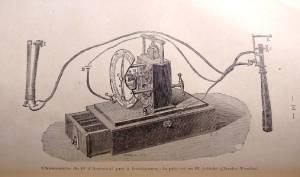
 "Chronomètre du D'Arsonval prêt a fonctionner" (D'Arsonval's chronometer ready to function) from Jean Philippe's Technique du chronomètre de D'Arsonval pour la mesure des temps psychiques (1899)
"Chronomètre du D'Arsonval prêt a fonctionner" (D'Arsonval's chronometer ready to function) from Jean Philippe's Technique du chronomètre de D'Arsonval pour la mesure des temps psychiques (1899)
Chronoscopes and chronometers—highly technical devices invented for the purposes of measuring very short durations of time—became instrumental objects in the founding of experimental and laboratory psychology at the end of the 19th century. Of particular importance in European and American settings were the Hipp chronoscope and the d’Arsonval chronometer. The former, designed by the German watchmaker Matthäus Hipp in the early 1840s, was largely adopted by German and American laboratories whose researchers focused on reaction time measurement experiments in highly controlled settings. The d'Arsonval chronometer, on the other hand, was favored by French researchers and medical clinicians who were interested in understanding individual differences in reaction times in a variety of non-experimental settings.
Invented in 1885 by the French polymath Jacques-Arsène d’Arsonval, the d’Arsonval chronometer had the ability to measure very short durations of up to 1/100th of a second using the power of electromagnetism. With its compact size and portability, it was considered by some to be a "major improvement" over the Hipp chronoscope, despite a dip in accuracy. The d'Arsonval chronometer became the tool of choice for French doctors and researchers who wanted to use reaction time measurements in psychiatric asylums, schools, and the military during the first half of the 20th century. Moreover, unlike the graphical method, which was also used for reaction time measurements during the 19th century, the d’Arsonval chronometer permitted researchers to move away from visual signs (traces) to the accumulation of numerical data. Reading numbers instead of images made comparisons between “normal” and “abnormal” reaction times easier and faster.
These characteristics enabled French doctors and researchers to use reaction time experiments in clinical settings. Antoine Rémond and Charles Féré, for example, used the d’Arsonval chronometer to conduct research on so-called “hysterical” patients, more often young women who were interned in asylums against their will. There, “slowed reactivity” was often considered a symptom of illness. Féré used the data he collected to argue that both depressed and hysterical patients showed a marked slowness in their reaction times. In elementary schools, other medical professionals used the d’Arsonval chronometer to qaulify certain students as “remarkably slow, heavy, and stupid.” These categorizations had profound effects on their school trajectories and beyond, and no doubt their sense of themselves, even if no historical record of the latter is available.
Mobilized psychologists and doctors continued to rely on the d’Arsonval chronometer during World War I. For example, Jean-Maurice Lahy, a psychologist and researcher who set up a wartime psychology laboratory, deployed the d’Arsonval chronometer to take reaction time measurements in combatants. His findings, once again, shored up the idea that slower reaction times could indicate one’s propensity for “fatigue” – a catch-all term that was also used to signal mental stress and psychic distress. Other wartime researchers used the d’Arsonval chronometer to demonstrate that the reaction times of soldiers with “no organic injuries”—meaning they demonstrated “hysterical symptoms” like “increased emotivity”—were different from those who had “strong constitutions” to withstand the stressors of war. In short, reaction time measurements were instrumental to distinctions made between those who were deemed “manly” and “unmanly” in the wartime context.
The ways the d’Arsonval chronometer was used in these settings show how medicalized mental chronometry and reaction time testing blurred the boundaries between diagnosis and optimization, between illness and “inferiority.” In this way, the d’Arsonval chronometer helped psychiatrists and psychologists valorize speed—or the ability to “act and think quickly”—as a barometer for mental health and encouraged the idea that mental and physical “slowness” was a pathological defect.
To follow on the dictionnary : Excess mortality in psychiatric hospitals
References :
Serge Nicolas and Peter B. Thompson, “The Hipp Chronoscope versus the D’Arsonval Chronometer. Laboratory Instruments Measuring Reaction Times That Distinguish German and French Orientations of Psychology,” History of Psychology 18, no. 4 (2015): 367-384.
Maia Woolner, “Time to Cure: Psychiatry, Psychology, and Speed in Modern France, c.1880s-1930s,” Unpublished PhD Dissertation, University of California, Los Angeles, 2020.
To quote this paper : Maia Woolner, "D'Arsonval chronometer" in Hervé Guillemain, DicoPolHiS, Le Mans Université, 2021.